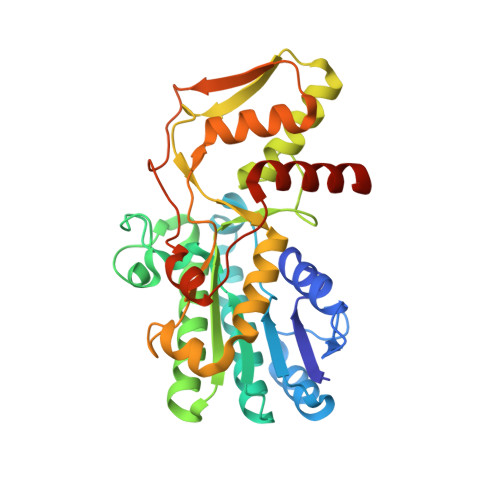Probing the Catalytic Mechanism of Gdp-4-Keto-6-Deoxy-D-Mannose Epimerase/Reductase by Kinetic and Crystallographic Characterization of Site-Specific Mutants
Rosano, C., Bisso, A., Izzo, G., Tonetti, M., Sturla, L., De Flora, A., Bolognesi, M.(2000) J Mol Biology 303: 77
- PubMed: 11021971
- DOI: https://doi.org/10.1006/jmbi.2000.4106
- Primary Citation of Related Structures:
1E6U, 1E7Q, 1E7R, 1E7S - PubMed Abstract:
GDP-4-keto-6-deoxy-d-mannose epimerase/reductase is a bifunctional enzyme responsible for the last step in the biosynthesis of GDP-l-fucose, the substrate of fucosyl transferases. Several cell-surface antigens, including the leukocyte Lewis system and cell-surface antigens in pathogenic bacteria, depend on the availability of GDP-l-fucose for their expression. Therefore, the enzyme is a potential target for therapy in pathological states depending on selectin-mediated cell-to-cell interactions. Previous crystallographic investigations have shown that GDP-4-keto-6-deoxy-d-mannose epimerase/reductase belongs to the short-chain dehydrogenase/reductase protein homology family. The enzyme active-site region is at the interface of an N-terminal NADPH-binding domain and a C-terminal domain, held to bind the substrate. The design, expression and functional characterization of seven site-specific mutant forms of GDP-4-keto-6-deoxy-d-mannose epimerase/reductase are reported here. In parallel, the crystal structures of the native holoenzyme and of three mutants (Ser107Ala, Tyr136Glu and Lys140Arg) have been investigated and refined at 1. 45-1.60 A resolution, based on synchrotron data (R-factors range between 12.6 % and 13.9 %). The refined protein models show that besides the active-site residues Ser107, Tyr136 and Lys140, whose mutations impair the overall enzymatic activity and may affect the coenzyme binding mode, side-chains capable of proton exchange, located around the expected substrate (GDP-4-keto-6-deoxy-d-mannose) binding pocket, are selectively required during the epimerization and reduction steps. Among these, Cys109 and His179 may play a primary role in proton exchange between the enzyme and the epimerization catalytic intermediates. Finally, the additional role of mutated active-site residues involved in substrate recognition and in enzyme stability has been analyzed.
- Department of Physics-INFM and Advanced Biotechnology Center-IST, University of Genova, Largo Rosanna Benzi 10, Genova, I-16132, Italy.
Organizational Affiliation:




















